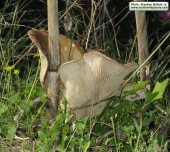So, I'm curious if anyone has played around with growing king oysters with the plants they associate with and if so, had any luck or changes in morphology/colonization rates, etc? Done anything else with King Oysters, like tried growing them on a log, etc?
Quote
Its species name is derived from the fact that it grows in association with the roots ofEryngium campestre or other Eryngium plants (English names: 'Sea Holly' or 'Eryngo'). P. eryngii is a species complex, and a number of varieties have been described, with differing plant associates in the carrot family (Apiaceae).
P. eryngii var. eryngii (DC.) Quél 1872 – associated with Eryngium ssp.
P. eryngii var. ferulae (Lanzi) Sacc. 1887 – associated with Ferula communis[4]
P. eryngii var. tingitanus Lewinsohn 2002 – associated with Ferula tingitana[4]
P. eryngii var. elaeoselini Venturella, Zervakis & La Rocca 2000 – associated with Elaeoselinum asclepium[5][6]
P. eryngii var. thapsiae Venturella, Zervakis & Saitta 2002 – associated with Thapsia garganica[7]
Other specimens of P. eryngii have been reported in association with plants in the generaFerulago, Cachrys, Laserpitium, and Diplotaenia.[2]
Molecular studies have shown Pleurotus nebrodensis to be closely related to, but distinct from, P. eryngii.[2] Pleurotus fossulatus may be another closely related species
I have heard some rumours that they have been, and that there is a picture of them growing with/on carrots.
I got curious and added a carrot and some poison hemlock seeds (both Apiaceae) to a bag of pasteurized straw that is colonizing - hoping that the hemlock seeds germinate and that the carrot grows some roots and leaves/stems --- Maybe it'll cause the mushrooms to do better or behave differently/better?
It'll be exciting to see if anything happens - guess is that it will be disappointing and not interact in a positive way, but the carrot only cost me $0.56 cents and maybe it could result in a cool King Oyster Mushroom Kit to sell on my marketplace,
www.vesp.co -- perhaps one that is a straw block that's mostly colonized with King oyster and then seeds/root of the plant established in the bag. It could be planted in the garden and have them grow big and large like they are do in the wild, unlike when cultivated on just straw alone.





